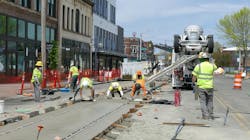Biden Administration calls for $621 billion in transportation investment over eight years
The Biden Administration released its proposal for a job and infrastructure plan on March 31 that will cost an estimated $2 trillion over eight years and will be funded through changes in the corporate tax code that the administration says incentivizes job creation, stops the shift to tax havens and makes large corporations responsible for “paying their fair share.”
According to a fact sheet on the proposal, the plan aims to tackle what the administration calls “the greatest challenges of our time,” which it says are climate change and the “ambitions of an autocratic China”:
It will invest in Americans and deliver the jobs and opportunities they deserve. But unlike past major investments, the plan prioritizes addressing long-standing and persistent racial injustice. The plan targets 40 percent of the benefits of climate and clean infrastructure investments to disadvantaged communities. And the plan invests in rural communities and communities impacted by the market-based transition to clean energy.
The proposal spans two plans: The American Jobs Plan, which is designed to create jobs and rebuild much of the country’s infrastructure and The Made in America Tax Plan, which is designed to fund the investments called for in The American Jobs Plan.
The American Jobs Plan calls for investments in transportation infrastructure, water and energy, commercial buildings and homes, as well as secure the supply chain in the U.S. and ensure jobs created by the plan have qualified workers ready to fill the positions.
The American Jobs Plan calls for a $621 billion transportation investment over an eight-year timeframe and would double the federal investment into public transit.
“Households that take public transportation to work have twice the commute time and households of color are twice as likely to take public transportation. Our current transit infrastructure is inadequate – the [U.S.] Department of Transportation estimates a repair backlog of over $105 billion, representing more than 24,000 buses, 5,000 rail cars, 200 stations and thousands of miles of track, signals and power systems in need of replacement,” the administration’s fact sheet reads.
In a speech laying out the proposal in Pittsburgh, President Joe Biden noted his commitment to making final legislation surrounding the proposals bipartisan and signaled his intent to bring leaders from the Republican party to the White House for negotiations.
"The divisions of the moment shouldn't stop us from doing the thing for the future," President Biden said.
What the proposal includes for transit
The administration says modernizing public transit will reduce the backlog of repair projects, connect more communities through bus, bus rapid transit and rail service and “ultimately reduce traffic congestion for everyone.”
Proposed investments the transit industry could benefit from include:
- $85 billion over eight years directly in public transit;
- $80 billion to address Amtrak’s repair backlog, modernize the Northeast Corridor, among other passenger rail investments, as well as enhance grant and loan programs for both passenger and freight rail;
- $115 billion to modernize the bridges, highways, roads and main streets that are in most critical need of repair; and
- $20 billion to improve road safety for all users, including increases to existing safety programs and a new Safe Streets for All program to fund state and local “vision zero” plans and other improvements to reduce crashes and fatalities, especially for cyclists and pedestrians.
The proposal also calls for a $25-billion investment in the nation’s airports to support several programs including support for multimodal connections and car-free access to air travel.
"The American Jobs Plan will build new rail corridors and transit lines, easing congestion, cutting pollution, slashing commute times and opening up investment in communities that can be connected to the cities and cities to the outskirts, where a lot of jobs are these days," said President Biden.
As previously noted, one of the proposal’s main goals is to improve climate change and transitioning to lower emissions vehicles is central to the administration’s plan. Not only would the proposal provide direct investment into EV market and encourage the construction of a national network of EV chargers, but it would include the replacement of 50,000 diesel transit vehicles with the support of the U.S. Department of Energy.
Additionally, the proposal recognizes past infrastructure investments have not benefited all areas of communities equally. The plan calls for $20 billion for a new program that will reconnect neighborhoods cut off by historic investments and ensure new projects increase opportunity, advance racial equity and environmental justice and promote affordable access.
While rural transit is not mentioned specifically in the proposal, the administration is calling for a new $5 billion Rural Partnership Program that would help rural and Tribal Nations “build on their unique assets and realize their vision for inclusive community and economic development.”
How to pay for the plan
The second plan introduced – The Made in America Tax Plan – would pay for The American Jobs Plan over 15 years by closing several corporate tax loop holes. The administration plans to set the corporate tax rate at 28 percent, which is an increase from the cuts implemented in 2017, but still lower than any other time going back to the World War II.
In addition to the corporate tax rate adjustment, the plan would change how multinational corporations are taxed by raising the global minimum tax rate to 21 percent. The administration would also encourage other countries to tax corporations appropriately to discourage the development of tax havens. The rule allowing U.S. companies to pay zero taxes on the first 10 percent of return when investments are located in foreign countries would also be eliminated. In support of the plan’s climate focus, special preferences, such as subsidies for the fossil fuel industry, would be eliminated.
Reactions to the proposal
Paul Skoutelas, president and CEO of the American Public Transportation Association, called the proposal transformational and said the time is right to make this kind of investment in the nation’s infrastructure.
“This forward-thinking investment in public transportation and passenger rail will help our communities meet growing mobility demands, create family-wage jobs, expand U.S. manufacturing and supply chains and grow the economy. It puts us on the path to increase access to opportunities for all Americans and build more equitable communities. The American Jobs Plan also addresses the environmental and sustainability challenges facing our communities, nation and the world. This plan will get projects off the ground and immediately create good-paying jobs that will get Americans back to work and ensure our communities keep moving,” said Skoutelas. “The American Jobs Plan recognizes the immediate need for public transit agencies to continue to provide essential services during the COVID-19 pandemic and support our nation’s economic recovery. APTA looks forward to continuing to work with Congress and the Biden Administration to achieve our common goal of building stronger and more equitable communities across our nation. The time is now to make a transformational investment in our national infrastructure.”
The Community Transportation Association of America (CTAA) saw the proposal as a needed move to address the public transportation infrastructure crisis and the association noted its willingness to partner with the administration to deliver modern and more equitable public transportation infrastructure.
“Much like the rest of the country, the rural and small city communities CTAA members serve have faced tremendous economic hardship as their surface transportation infrastructure — including transit vehicles and facilities — have fallen increasingly into disrepair and outlived their useful lives. Throughout, CTAA members continue to deliver safe, affordable and equitable transportation options in the face of these infrastructure challenges. President Biden’s infrastructure plan proposes to invest $85 billion to assist all forms of public transportation in expanding and modernizing fleets and facilities. This is a long-needed step in addressing the capital and infrastructure crisis in public transportation,” the association said in a statement of support for the plan. “We are looking forward to working in partnership with Congress and the Biden Administration on improving the nation’s surface transportation infrastructure, reauthorizing the FAST Act and ensuring that all Americans have access to equitable, quality of life-improving transportation that can best be delivered with modern, efficient public transportation infrastructure.”
California Transit Association’s Executive Director Michael Pimentel applauded the proposal and encouraged Congressional leaders to deliver on the plan’s promise.
“This unprecedented investment would not only double the level of federal funding California’s transit agencies receive for transit projects annually, but it would also significantly bolster our ability to transition to 100 percent zero-emission bus fleets by 2040 as required by the state. The American Jobs Plan includes $174 billion for domestic investments in electric vehicle and battery manufacturing to facilitate, among other things, the transition of 50,000 transit buses nationwide to zero-emission bus technologies. This investment will help grow the increasingly California-based manufacturing of these technologies fueling the zero-emission bus transformation across the country. The plan would also provide a four-fold increase in investment in rail projects nationwide, further augmenting our state’s leadership in developing a robust and sustainable rail network,” said Pimentel.
Janette Sadik-Khan, chair of the National Association of City Transportation Officials (NACTO), called the proposal “the most visionary proposal for the nation's transportation network since the dawn of the interstate highway system” and praised the administration for laying the groundwork to prioritize people, safety and climate.”
“How much we fund infrastructure is half of the equation; what we spend it on is the other,” added Corinne Kisner, executive director of NACTO. “The Biden Administration’s plan is a dramatic shift from the business-as-usual approach to transportation funding and can fundamentally reshape what we get from the streets in our cities and neighborhoods. Realizing this vision will also require removing the many structural impediments to progress, from outdated federal design standards to how funding actually flows to local communities. We’re heartened by the conversation to date and look forward to working closely with the administration and Congress to make sure the details meet the needs of American cities and people.”
-------------------
Updated 10:55 am April 1 to incorporate CTAA statement.
About the Author

Mischa Wanek-Libman
Group Editorial Director
Mischa Wanek-Libman is director of communications with Transdev North America. She has more than 20 years of experience working in the transportation industry covering construction projects, engineering challenges, transit and rail operations and best practices.
Wanek-Libman has held top editorial positions at freight rail and public transportation business-to-business publications including as editor-in-chief and editorial director of Mass Transit from 2018-2024. She has been recognized for editorial excellence through her individual work, as well as for collaborative content.
She is an active member of the American Public Transportation Association's Marketing and Communications Committee and served 14 years as a Board Observer on the National Railroad Construction and Maintenance Association (NRC) Board of Directors.
She is a graduate of Drake University in Des Moines, Iowa, where she earned a Bachelor of Arts degree in Journalism and Mass Communication.
